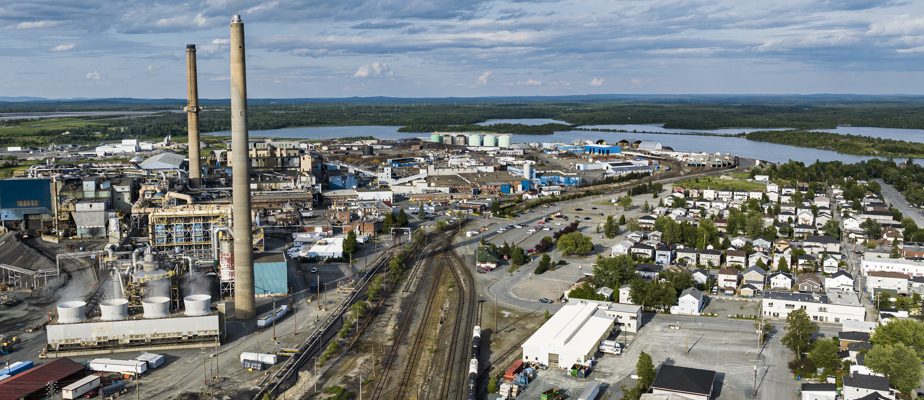(Quebec) Approximately 200 households in Rouyn-Noranda will be relocated with the creation of a “buffer zone” near the Horne Foundry, in the area most exposed to emissions of arsenic and other air pollutants. The Legault government will extend around $85 million to notably build a new neighborhood and support the City in its economic diversification.
According to the action plan that the Legault government will present on Thursday and whose The Press has obtained the outline, the multinational Glencore will pay for the acquisition and demolition of the 80 buildings located in the north of the Notre-Dame district, close to the foundry, where the buffer zone will be delimited. The company will bear the costs of greening this area.
Quebec will also unveil the new ministerial authorization for the Horne Foundry on Thursday. If he tightens certain obligations, he maintains a position which has been the subject of the most heated debates: he will require that the foundry reach, within five years, an annual average of 15 nanograms of arsenic per cubic meter of air , which is five times higher than the Quebec standard. New element, it will still require Glencore to present a plan to eventually reach this standard of three nanograms.
Ministers Benoit Charette (Environment) and Andrée Laforest (Municipal Affairs) will travel to Rouyn-Noranda to give details of the ministerial authorization and the government’s action plan.
After many discussions with the City and Glencore, Quebec is moving forward with the creation of a “buffer zone” to protect the health of the population. This is the enlargement of the “transition zone” which was created in the past; Glencore acquired a few houses and demolished them as part of a voluntary program.
Quebec aims for the relocation of the 200 households living in the new buffer zone to be done by mutual agreement, after discussions. No one will be forced to leave their home until they have found a new home. The operation will be spread over two to three years.
The 80 buildings concerned will be bought and demolished by the company. The land value of these properties and land was $20 million in 2021.
In its action plan, Quebec provides assistance to relocate households and build a new neighborhood. The City has already identified potential sites. Tenants of apartments located in the buffer zone will be entitled to support; the payment of compensation is discussed behind the scenes.
The buffer zone debated since 2019
The creation of a buffer zone has been debated for quite some time in Rouyn-Noranda. In 2019, the Public Health Department of Abitibi-Témiscamingue recommended the establishment of such a zone among “solutions [qui] could be combined with Glencore’s efforts to reduce its pollutant emissions. She returned to the charge with this proposal in a notice published last year.

PHOTO EDOUARD PLANTE-FRÉCHETTE, THE PRESS
Last August, the government required the smelter to reach, within five years, an annual average of 15 ng/m3 of arsenic, which is five times higher than the Quebec standard. Residents of the Notre-Dame district rejected this proposal by 70%.
For its part, Glencore mentioned in 2019 the possibility of a buffer zone in an “action plan for the reduction of atmospheric emissions”. She was however resistant to this option last year, but she had not closed the door twice.
The City had shown itself open to a buffer zone. In her brief submitted during public consultations with the Ministry of the Environment last year, she pointed out, however, that “the lack of information surrounding a possible buffer zone as well as the various measures recommended by Public Health to limit the exposure of individuals create a particularly anxiety-provoking living environment”.
During his visit to Rouyn-Noranda during the election campaign, Prime Minister François Legault had mentioned discussions with Glencore around the creation of a buffer zone. He had then met the members of the municipal council. The City subsequently asked the government for an action plan to help it in its recovery.
The Legault government is releasing approximately 85 million in five years to develop a new neighborhood, rehabilitate contaminated land, diversify the economy and increase the attractiveness of the region.
Quebec will also set up an independent monitoring committee to ensure that the Horne Foundry complies with the requirements of its new ministerial authorization.
Tighten emissions requirements
Due to a controversy over the foundry’s pollutant emissions and the associated health risks to the population, the Legault government had undertaken to raise the requirements imposed on the company under the authorization former. Until now, the limit imposed on the foundry was 100 nanograms of arsenic per cubic meter of air.
He proposed last August to require the foundry to reach within five years an annual average of 15 nanograms of arsenic per cubic meter of air, which is five times higher than the Quebec standard (3 ng/m3).
Public Health argued that this threshold is acceptable as an “intermediate step towards achieving the standard” of 3 nanograms.
The government has argued – as has Glencore – that it is technically impossible for the smelter to meet Quebec’s arsenic emissions standard at this time.
However, a majority of citizens of Rouyn-Noranda (58%) rejected the proposal for a ceiling of 15 nanograms (70% in the Notre-Dame district), according to the results of the public consultation of the government unveiled in December. And 63% said they disagreed with the idea of giving the company a period of five years to lower its emissions below this ceiling (76% in the Notre-Dame district).
Benoit Charette said at the end of January that the requirements imposed on Glencore in the new authorization will be “strengthened” compared to the proposal made last year thanks to an independent analysis of the company’s ability to reduce its emissions of contaminants. He will announce the tightening of certain obligations while maintaining the new ceiling for arsenic emissions at 15 nanograms within five years.
